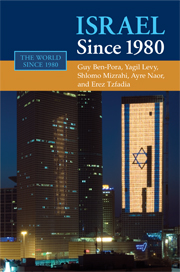Book contents
- Frontmatter
- Contents
- List of Figures
- List of Tables
- List of Abbreviations
- Introduction
- 1 Israeli Society: Diversity, Tensions, and Governance
- 2 Geography and Demography: Spatial Transformations
- 3 The Political System: Government, Parliament, and the Court
- 4 Political Economy: Liberalization and Globalization
- 5 Military–Society Relations: the Demise of the “People's Army”
- 6 The New Politics: Interest Groups and Alternative Channels
- Conclusion: the State of the State
- Index
- References
5 - Military–Society Relations: the Demise of the “People's Army”
Published online by Cambridge University Press: 14 May 2010
- Frontmatter
- Contents
- List of Figures
- List of Tables
- List of Abbreviations
- Introduction
- 1 Israeli Society: Diversity, Tensions, and Governance
- 2 Geography and Demography: Spatial Transformations
- 3 The Political System: Government, Parliament, and the Court
- 4 Political Economy: Liberalization and Globalization
- 5 Military–Society Relations: the Demise of the “People's Army”
- 6 The New Politics: Interest Groups and Alternative Channels
- Conclusion: the State of the State
- Index
- References
Summary
“The civilian is a soldier on eleven months' annual leave.” That sentiment, expressed in the early 1950s by General Yigael Yadin, the second Chief of the General Staff of the Israel Defense Forces (IDF), has prevailed throughout Israel's history. Israelis have long viewed the IDF as more than simply the military; in popular mythology, the IDF is “the people's army,” a crucial institution for both the defense of the state and the self-image of the nation. Nevertheless, the relationship between the Jewish-Israeli society and its army has been a tumultuous one. From its lofty status as a powerful “people's army” in the mid-1950s, the army has met with a succession of crises since the 1973 war, which intensified following its display of weakness in the First Lebanon War (1982–5) and the first Intifada (1987–93). These crises have led to a dilution of the army's resources, a reduction in its political support, a decline in its symbols, and even its gradual abandonment by social elites. The Al-Aqsa Intifada, the second major wave of violence between Israel and the Palestinians, which erupted in September 2000, filled the army's sails with fresh wind, though only temporarily. The Disengagement Plan (summer of 2005) placed the army once again in the midst of the political debate. Then the Second Lebanon War (summer of 2006) worsened the army's status. The prospect of replacing the drafted “people's army” with a voluntary-professional military, something not considered in the past, is now seriously discussed.
- Type
- Chapter
- Information
- Israel since 1980 , pp. 117 - 145Publisher: Cambridge University PressPrint publication year: 2008



